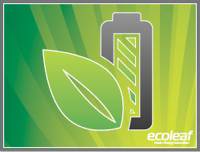ECOLEAF: Energy-Driven Innovation

All of our efforts should be focused on unearthing the solutions that will transform all current and future carbon-polluting power plants to becoming environmentally-clean power plants. This will mean combining technologies, from exploring battery storage issues to fuel cell solutions and examining everything from super capacitors to flywheels. New solutions should embrace both far-flung and widely-distributed energy systems that could take advantage of economies of scale. New systems will need to be able to compete during both daytime and nighttime hours; new systems will also have to be able to provide reliable 24-hour energy 365 days a year.
INVESTING IN THE FUTURE
President Obama has set two stretch target goals for the U.S. One might be achieved; the other, however, will require extensive investments and policies to facilitate.
The first goal is to achieve 10% of America’s energy from renewables by 2012. Currently, hydroelectric, wind, solar, geothermal, and biomass energies produce a total of 9% of the country’s energy requirements. An additional 1% will require having 173 MWh of new clean energy production available for consumption. If the new capacity were composed solely of wind energy, 79 GW of capacity would be required. To put this into perspective, in 2006, the total wind capacity in the U.S. was 11.8GW, and throughout the course of the year, only 2.4GW of new capacity was installed. To reach 79GW would be a challenge in terms of scaling up production and installation.
The President’s second goal is a much larger stretch. That goal is to achieve 25% from renewable energies by 2025. Since energy use is increasing year after year, in 2025, energy production will be 41.5% higher than it was in 2005 (when the U.S. generated 2014 billion kWh). By 2025, 713 billion kWh of new energy must come from renewables. To achieve this, roughly $600 billion dollars will have to be invested—in addition to funds for new infrastructure—to connect the renewable power production to the electrical grid.
This also means that in the future, all new power plants will have to be 100% renewable. The only exception to this will be current carbon-based power plants that are in need of replacement and upgrades.
This energy-geared future will lead to a new multi-billion dollar marketplace for renewable energy innovation (and that’s just in the U.S.). Globally, this green-energy push would entail tens of trillions of investment dollars over the next 20 years. The ones who can create low-cost efficiencies for reliable green energy will be the ones who will reap the financial rewards.
ENERGY-DRIVEN INNOVATION



Stay Informed
Get updates and action alerts.



back
next

Delivering Green Clarity in a Carbon-Troubled World™
Copyright © 2008 - 2010 by ECOLEAF™. All rights reserved.
Reproduction in whole or in part without permission is prohibited.
